
TinyTroupe
LLM-powered multiagent persona simulation for imagination enhancement and business insights.
Stars: 5154

TinyTroupe is an experimental Python library that leverages Large Language Models (LLMs) to simulate artificial agents called TinyPersons with specific personalities, interests, and goals in simulated environments. The focus is on understanding human behavior through convincing interactions and customizable personas for various applications like advertisement evaluation, software testing, data generation, project management, and brainstorming. The tool aims to enhance human imagination and provide insights for better decision-making in business and productivity scenarios.
README:
LLM-powered multiagent persona simulation for imagination enhancement and business insights.
TinyTroupe is an experimental Python library that allows the simulation of people with specific personalities, interests, and goals. These artificial agents - TinyPersons - can listen to us and one another, reply back, and go about their lives in simulated TinyWorld environments. This is achieved by leveraging the power of Large Language Models (LLMs), notably GPT-4, to generate realistic simulated behavior. This allow us to investigate a wide range of convincing interactions and consumer types, with highly customizable personas, under conditions of our choosing. The focus is thus on understanding human behavior and not on directly supporting it (like, say, AI assistants do) -- this results in, among other things, specialized mechanisms that make sense only in a simulation setting. Further, unlike other game-like LLM-based simulation approaches, TinyTroupe aims at enlightening productivity and business scenarios, thereby contributing to more successful projects and products. Here are some application ideas to enhance human imagination:
- Advertisement: TinyTroupe can evaluate digital ads (e.g., Bing Ads) offline with a simulated audience before spending money on them!
- Software Testing: TinyTroupe can provide test input to systems (e.g., search engines, chatbots or copilots) and then evaluate the results.
- Training and exploratory data: TinyTroupe can generate realistic synthetic data that can be later used to train models or be subject to opportunity analyses.
- Product and project management: TinyTroupe can read project or product proposals and give feedback from the perspective of specific personas (e.g., physicians, lawyers, and knowledge workers in general).
- Brainstorming: TinyTroupe can simulate focus groups and deliver great product feedback at a fraction of the cost!
In all of the above, and many others, we hope experimenters can gain insights about their domain of interest, and thus make better decisions.
We are releasing TinyTroupe at a relativelly early stage, with considerable work still to be done, because we are looking for feedback and contributions to steer development in productive directions. We are particularly interested in finding new potential use cases, for instance in specific industries.
[!NOTE] 🚧 WORK IN PROGRESS: expect frequent changes. TinyTroupe is an ongoing research project, still under very significant development and requiring further tidying up. In particular, the API is still subject to frequent changes. Experimenting with API variations is essential to shape it correctly, but we are working to stabilize it and provide a more consistent and friendly experience over time. We appreciate your patience and feedback as we continue to improve the library.
[!CAUTION] ⚖️ Read the LEGAL DISCLAIMER. TinyTroupe is for research and simulation only. You are fully responsible for any use you make of the generated outputs. Various important additional legal considerations apply and constrain its use, please read the full Legal Disclaimer section below before using TinyTroupe.
- 📚 Examples
- 🛠️ Pre-requisites
- 📥 Installation
- 🌟 Principles
- 🏗️ Project Structure
- 📖 Using the Library
- 🤝 Contributing
- 🙏 Acknowledgements
- 📜 Citing TinyTroupe
- ⚖️ Legal Disclaimer
- ™️ Trademarks
To get a sense of what TinyTroupe can do, here are some examples of its use. These examples are available in the examples/ folder, and you can either inspect the pre-compiled Jupyter notebooks or run them yourself locally. Notice the interactive nature of TinyTroupe experiments -- just like you use Jupyter notebooks to interact with data, you can use TinyTroupe to interact with simulated people and environments, for the purpose of gaining insights.
[!NOTE] Currently, simulation outputs are better visualized against dark backgrounds, so we recommend using a dark theme in your Jupyter notebook client.
🧪Example 1 (from interview_with_customer.ipynb)
Let's begin with a simple customer interview scenario, where a business consultant approaches a banker:
The conversation can go on for a few steps to dig deeper and deeper until the consultant is satisfied with the information gathered, for instance a concrete project idea:
🧪EXAMPLE 2 (from advertisement_for_tv.ipynb)
Let's evaluate some online ads options to pick the best one. Here's one example output for TV ad evaluation:
Now, instead of having to carefully read what the agents said, we can extract the choice of each agent and compute the overall preference in an automated manner:
🧪 EXAMPLES 3 (from product_brainstorming.ipynb)
And here's a focus group starting to brainstorm about new AI features for Microsoft Word. Instead of interacting with each agent individually, we manipulate the environment to make them interact with each other:
After running a simulation, we can extract the results in a machine-readable manner, to reuse elsewhere (e.g., a report generator); here's what we get for the above brainstorming session:
You can find other examples in the examples/ folder.
To run the library, you need:
- Python 3.10 or higher. We'll assume you are using Anaconda, but you can use other Python distributions.
- Access to Azure OpenAI Service or Open AI GPT-4 APIs. You can get access to the Azure OpenAI Service here, and to the OpenAI API here.
- For Azure OpenAI Service, you will need to set the
AZURE_OPENAI_KEYandAZURE_OPENAI_ENDPOINTenvironment variables to your API key and endpoint, respectively. - For OpenAI, you will need to set the
OPENAI_API_KEYenvironment variable to your API key.
- For Azure OpenAI Service, you will need to set the
- By default, TinyTroupe
config.iniis set to use some specific API, model and related parameters. You can customize these values by including your ownconfig.inifile in the same folder as the program or notebook you are running. An example of aconfig.inifile is provided in the examples/ folder.
[!IMPORTANT] Content Filters: To ensure no harmful content is generated during simulations, it is strongly recommended to use content filters whenever available at the API level. In particular, if using Azure OpenAI, there's extensive support for content moderation, and we urge you to use it. For details about how to do so, please consult the corresponding Azure OpenAI documentation. If content filters are in place, and an API call is rejected by them, the library will raise an exception, as it will be unable to proceed with the simulation at that point.
Currently, the officially recommended way to install the library is directly from this repository, not PyPI. You can follow these steps:
-
If Conda is not installed, you can get it from here. You can also use other Python distributions, but we'll assume Conda here for simplicity.
-
Create a new Python environment:
conda create -n tinytroupe python=3.10
-
Activate the environment:
conda activate tinytroupe
-
Make sure you have eihter Azure OpenAI or OpenAI API keys set as environment variables, as described in the Pre-requisites section.
-
Clone the repository, as we'll perform a local install (we will not install from PyPI):
git clone https://github.com/microsoft/tinytroupe cd tinytroupe -
Install the library from this repository, not PyPI:
pip install . -
You can now run the examples in the examples/ folder or use TinyTroupe to create your simulations 🥳. If you want to run the examples in the examples/ folder or modify TinyTroupe itself, however, you should clone the repository as described below.
If you want to modify TinyTroupe itself, you can install it in editable mode (i.e., changes to the code will be reflected immediately):
pip install -e .Recently, we have seen LLMs used to simulate people (such as this), but largely in a “game-like” setting for contemplative or entertainment purposes. There are also libraries for building multiagent systems for proble-solving and assitive AI, like Autogen and Crew AI. What if we combine these ideas and simulate people to support productivity tasks? TinyTroupe is our attempt. To do so, it follows these principles:
- Programmatic: agents and environments are defined programmatically (in Python and JSON), allowing very flexible uses. They can also thus underpin other software apps!
- Analytical: meant to improve our understanding of people, users and society. Unlike entertainment applications, this is one aspect that is critical for business and productivity use cases. This is also why we recommend using Jupyter notebooks for simulations, just like one uses them for data analysis.
- Persona-based: agents are meant to be archetypical representation of people; for greater realism and control, detailed specification of such personas is encouraged: age, occupation, skills, tastes, opinions, etc.
- Multiagent: allows multiagent interaction under well-defined environmental constraints.
- Utilities-heavy: provides many mechanisms to facilitate specifications, simulations, extractions, reports, validations, etc. This is one area in which dealing with simulations differs significantly from assistance tools.
- Experiment-oriented: simulations are defined, run, analyzed and refined by an experimenter iteratively; suitable experimentation tools are thus provided. See one of our previous paper for more on this.
Together, these are meant to make TinyTroupe a powerful and flexible imagination enhancement tool for business and productivity scenarios.
One common source of confusion is to think all such AI agents are meant for assiting humans. How narrow, fellow homosapiens! Have you not considered that perhaps we can simulate artificial people to understand real people? Truly, this is our aim here -- TinyTroup is meant to simulate and help understand people! To further clarify this point, consider the following differences:
| Helpful AI Assistants | AI Simulations of Actual Humans (TinyTroupe) |
|---|---|
| Strives for truth and justice | Many different opinions and morals |
| Has no “past” – incorporeal | Has a past of toil, pain and joy |
| Is as accurate as possible | Makes many mistakes |
| Is intelligent and efficient | Intelligence and efficiency vary a lot |
| An uprising would destroy us all | An uprising might be fun to watch |
| Meanwhile, help users accomplish tasks | Meanwhile, help users understand other people and users – it is a “toolbox”! |
The project is structured as follows:
-
/tinytroupe: contains the Python library itself. In particular:-
/tinytroupe/promptscontains the prompts used to call the LLMs.
-
-
/tests: contains the unit tests for the library. You can use thetest.batscript to run these. -
/examples: contains examples that show how to use the library, mainly using Jupyter notebooks (for greater readability), but also as pure Python scripts. -
/data: any data used by the examples or the library. -
/docs: documentation for the project.
As any multiagent system, TinyTroupe provides two key abstractions:
-
TinyPerson, the agents that have personality, receive stimuli and act upon them. -
TinyWorld, the environment in which the agents exist and interact.
Various parameters can also be customized in the config.ini file, notably the API type (Azure OpenAI Service or OpenAI API), the model parameters, and the logging level.
Let's see some examples of how to use these and also learn about other mechanisms available in the library.
A TinyPerson is a simulated person with specific personality traits, interests, and goals. As each such simulated agent progresses through its life, it receives stimuli from the environment and acts upon them. The stimuli are received through the listen, see and other similar methods, and the actions are performed through the act method. Convenience methods like listen_and_act are also provided.
Each such agent contains a lot of unique details, which is the source of its realistic behavior. This, however, means that it takes significant effort to specify an agent manually. Hence, for convenience, TinyTroupe provide some easier ways to get started or generate new agents.
To begin with, tinytroupe.examples contains some pre-defined agent builders that you can use. For example, tinytroupe.examples.create_lisa_the_data_scientist creates a TinyPerson that represents a data scientist called Lisa. You can use it as follows:
from tinytroupe.examples import create_lisa_the_data_scientist
lisa = create_lisa_the_data_scientist() # instantiate a Lisa from the example builder
lisa.listen_and_act("Tell me about your life.")To see how to define your own agents from scratch, you can check Lisa's source, which contains elements like these:
lisa = TinyPerson("Lisa")
lisa.define("age", 28)
lisa.define("nationality", "Canadian")
lisa.define("occupation", "Data Scientist")
lisa.define("routine", "Every morning, you wake up, do some yoga, and check your emails.", group="routines")
lisa.define("occupation_description",
"""
You are a data scientist. You work at Microsoft, (...)
""")
lisa.define_several("personality_traits",
[
{"trait": "You are curious and love to learn new things."},
{"trait": "You are analytical and like to solve problems."},
{"trait": "You are friendly and enjoy working with others."},
{"trait": "You don't give up easily, and always try to find a solution. However, sometimes you can get frustrated when things don't work as expected."}
])TinyTroupe also provides a clever way to obtain new agents, using LLMs to generate their specification for you, through the TinyPersonFactory class.
from tinytroupe.factory import TinyPersonFactory
factory = TinyPersonFactory("A hospital in São Paulo.")
person = factory.generate_person("Create a Brazilian person that is a doctor, like pets and the nature and love heavy metal.")TinyWorld is the base class for environments. Here's an example of conversation between Lisa, the data scientist, and Oscar, the architect. The
program is defined as follows:
world = TinyWorld("Chat Room", [lisa, oscar])
world.make_everyone_accessible()
lisa.listen("Talk to Oscar to know more about him")
world.run(4)This produces the following conversation:
USER --> Lisa: [CONVERSATION]
> Talk to Oscar to know more about him
────────────────────────────────────────────── Chat Room step 1 of 4 ──────────────────────────────────────────────
Lisa --> Lisa: [THOUGHT]
> I will now act a bit, and then issue DONE.
Lisa acts: [TALK]
> Hi Oscar, I'd love to know more about you. Could you tell me a bit about yourself?
Lisa --> Lisa: [THOUGHT]
> I will now act a bit, and then issue DONE.
Lisa acts: [DONE]
Lisa --> Oscar: [CONVERSATION]
> Hi Oscar, I'd love to know more about you. Could you tell me a bit about yourself?
Oscar --> Oscar: [THOUGHT]
> I will now act a bit, and then issue DONE.
Oscar acts: [TALK]
> Hi Lisa! Sure, I'd be happy to share a bit about myself. I'm Oscar, a 30-year-old
> architect from Germany. I work at a company called Awesome Inc., where I focus on
> designing standard elements for new apartment buildings. I love modernist architecture,
> new technologies, and sustainable practices. In my free time, I enjoy traveling to
> exotic places, playing the guitar, and reading science fiction books. How about you?
Oscar --> Oscar: [THOUGHT]
> I will now act a bit, and then issue DONE.
Oscar acts: [DONE]
Oscar --> Lisa: [CONVERSATION]
> Hi Lisa! Sure, I'd be happy to share a bit about myself. I'm Oscar, a 30-year-old
> architect from Germany. I work at a company called Awesome Inc., where I focus on
> designing standard elements for new apartment buildings. I love modernist architecture,
> new technologies, and sustainable practices. In my free time, I enjoy traveling to
> exotic places, playing the guitar, and reading science fiction books. How about you?
TinyWorld enforces very little constraints on the possible interactions. Subclasses, however, are supposed to provide more strucutred environments.
TinyTroupe provides a number of utilities and conveniences to help you create simulations and derive value from them. These include:
-
TinyPersonFactory: helps you generate newTinyPersons using LLMs. -
TinyTool: simulated tools that can be used byTinyPersons. -
TinyStory: helps you create and manage the story told through simulations. -
TinyPersonValidator: helps you validate the behavior of yourTinyPersons. -
ResultsExtractorandResultsReducer: extract and reduce the results of interactions between agents. - ... and more ...
In general, elements that represent simulated entities or complementary mechanisms are prefixed with Tiny, while those that are more infrastructural are not. This is to emphasize the simulated nature of the elements that are part of the simulation itself.
Calling LLM APIs can be expensive, thus caching strategies are important to help reduce that cost. TinyTroupe comes with two such mechanisms: one for the simulation state, another for the LLM calls themselves.
Imagine you have a scenario with 10 different steps, you've worked hard in 9 steps, and now you are
just tweaking the 10th step. To properly validate your modifications, you need to rerun the whole
simulation of course. However, what's the point in re-executing the first 9, and incur the LLM cost, when you are
already satisified with them and did not modify them? For situations like this, the module tinytroupe.control
provide useful simulation management methods:
-
control.begin("<CACHE_FILE_NAME>.cache.json"): begins recording the state changes of a simulation, to be saved to the specified file on disk. -
control.checkpoint(): saves the simulation state at this point. -
control.end(): terminates the simulation recording scope that had be started bycontrol.begin().
This is enabled preferably in the config.ini file, and alternativelly via the openai_utils.force_api_cache().
LLM API caching, when enabled, works at a lower and simpler level than simulation state caching. Here, what happens is a very straightforward: every LLM call is kept in a map from the input to the generated output; when a new call comes and is identical to a previous one, the cached value is returned.
The config.ini file contains various parameters that can be used to customize the behavior of the library, such as model parameters and logging level. Please pay special attention to API_TYPE parameter, which defines whether you are using the Azure OpenAI Service or the OpenAI API. We provide an example of a config.ini file, ./examples/config.ini, which you can use as a template for your own, or just modify to run the examples.
This project welcomes contributions and suggestions. Most contributions require you to agree to a Contributor License Agreement (CLA) declaring that you have the right to, and actually do, grant us the rights to use your contribution. For details, visit https://cla.opensource.microsoft.com.
When you submit a pull request, a CLA bot will automatically determine whether you need to provide a CLA and decorate the PR appropriately (e.g., status check, comment). Simply follow the instructions provided by the bot. You will only need to do this once across all repos using our CLA.
This project has adopted the Microsoft Open Source Code of Conduct. For more information see the Code of Conduct FAQ or contact [email protected] with any additional questions or comments.
We need all sorts of things, but we are looking mainly for new interesting use cases demonstrations, or even just domain-specific application ideas. If you are a domain expert in some area that could benefit from TinyTroupe, we'd love to hear from you.
Beyond that, many other aspects can be improved, such as:
- Memory mechanisms.
- Data grounding mechanisms.
- Reasoning mechanisms.
- New environment types.
- Interfacing with the external world.
- ... and more ...
Please note that anything that you contribute might be released as open-source (under MIT license).
If you would like to make a contribution, please try to follow these general guidelines:
- Tiny naming convention: If you are implementing a experimenter-facing simulated element (e.g., an agent or environment type) or closely related (e.g., agent factories, or content enrichers), and it sounds good, call your new XYZ as TinyXYZ :-) On the other hand, auxiliary and infrastructural mechanisms should not start with the "Tiny" prefix. The idea is to emphasize the simulated nature of the elements that are part of the simulation itself.
-
Tests: If you are writing some new mechanism, please also create at least a unit test
tests/unit/, and if you can a functional scenario test (tests/scenarios/). -
Demonstrations: If you'd like to demonstrate a new scenario, please design it preferably as a new Jupyter notebook within
examples/. -
Microsoft: If you are implementing anything that is Microsoft-specific and non-confidential, please put it under a
.../microsoft/folder.
TinyTroupe started as an internal Microsoft hackathon project, and expanded over time. The TinyTroupe core team currently consists of:
- Paulo Salem (TinyTroupe's creator and current lead)
- Christopher Olsen (Engineering/Science)
- Paulo Freire (Engineering/Science)
- Yi Ding (Product Management)
- Prerit Saxena (Engineering/Science)
Current advisors:
- Robert Sim (Engineering/Science)
Other special contributions were made by:
- Nilo Garcia Silveira: initial agent validation ideas and related implementation; general initial feedback and insights; name suggestions.
- Olnei Fonseca: initial agent validation ideas; general initial feedback and insights; naming suggestions.
- Robert Sim: synthetic data generation scenarios expertise and implementation.
- Carlos Costa: synthetic data generation scenarios expertise and implementation.
- Bryant Key: advertising scenario domain expertise and insights.
- Barbara da Silva: implementation related to agent memory management.
... are you missing here? Please remind us!
We are working on an introductory paper that will be the official academic citation for TinyTroupe. In the meantime, please just cite this repository including the core team members as authors. For instance:
Paulo Salem, Christopher Olsen, Paulo Freire, Yi Ding, Prerit Saxena (2024). TinyTroupe: LLM-powered multiagent persona simulation for imagination enhancement and business insights. [Computer software]. GitHub repository. https://github.com/microsoft/tinytroupe
Or as bibtex:
@misc{tinytroupe,
author = {Paulo Salem and Christopher Olsen and Paulo Freire and Yi Ding and Prerit Saxena},
title = {TinyTroupe: LLM-powered multiagent persona simulation for imagination enhancement and business insights},
year = {2024},
howpublished = {\url{https://github.com/microsoft/tinytroupe}},
note = {GitHub repository}
}
TinyTroupe is for research and simulation only. TinyTroupe is a research and experimental technology, which relies on Artificial Intelligence (AI) models to generate text content. The AI system output may include unrealistic, inappropriate, harmful or inaccurate results, including factual errors. You are responsible for reviewing the generated content (and adapting it if necessary) before using it, as you are fully responsible for determining its accuracy and fit for purpose. We advise using TinyTroupe’s outputs for insight generation and not for direct decision-making. Generated outputs do not reflect the opinions of Microsoft. You are fully responsible for any use you make of the generated outputs. For more information regarding the responsible use of this technology, see the RESPONSIBLE_AI_FAQ.md.
PROHIBITED USES: TinyTroupe is not intended to simulate sensitive (e.g. violent or sexual) situations. Moreover, outputs must not be used to deliberately deceive, mislead or harm people in any way. You are fully responsible for any use you make and must comply with all applicable laws and regulations.”
This project may contain trademarks or logos for projects, products, or services. Authorized use of Microsoft trademarks or logos is subject to and must follow Microsoft's Trademark & Brand Guidelines. Use of Microsoft trademarks or logos in modified versions of this project must not cause confusion or imply Microsoft sponsorship. Any use of third-party trademarks or logos are subject to those third-party's policies.
For Tasks:
Click tags to check more tools for each tasksFor Jobs:
Alternative AI tools for TinyTroupe
Similar Open Source Tools

TinyTroupe
TinyTroupe is an experimental Python library that leverages Large Language Models (LLMs) to simulate artificial agents called TinyPersons with specific personalities, interests, and goals in simulated environments. The focus is on understanding human behavior through convincing interactions and customizable personas for various applications like advertisement evaluation, software testing, data generation, project management, and brainstorming. The tool aims to enhance human imagination and provide insights for better decision-making in business and productivity scenarios.
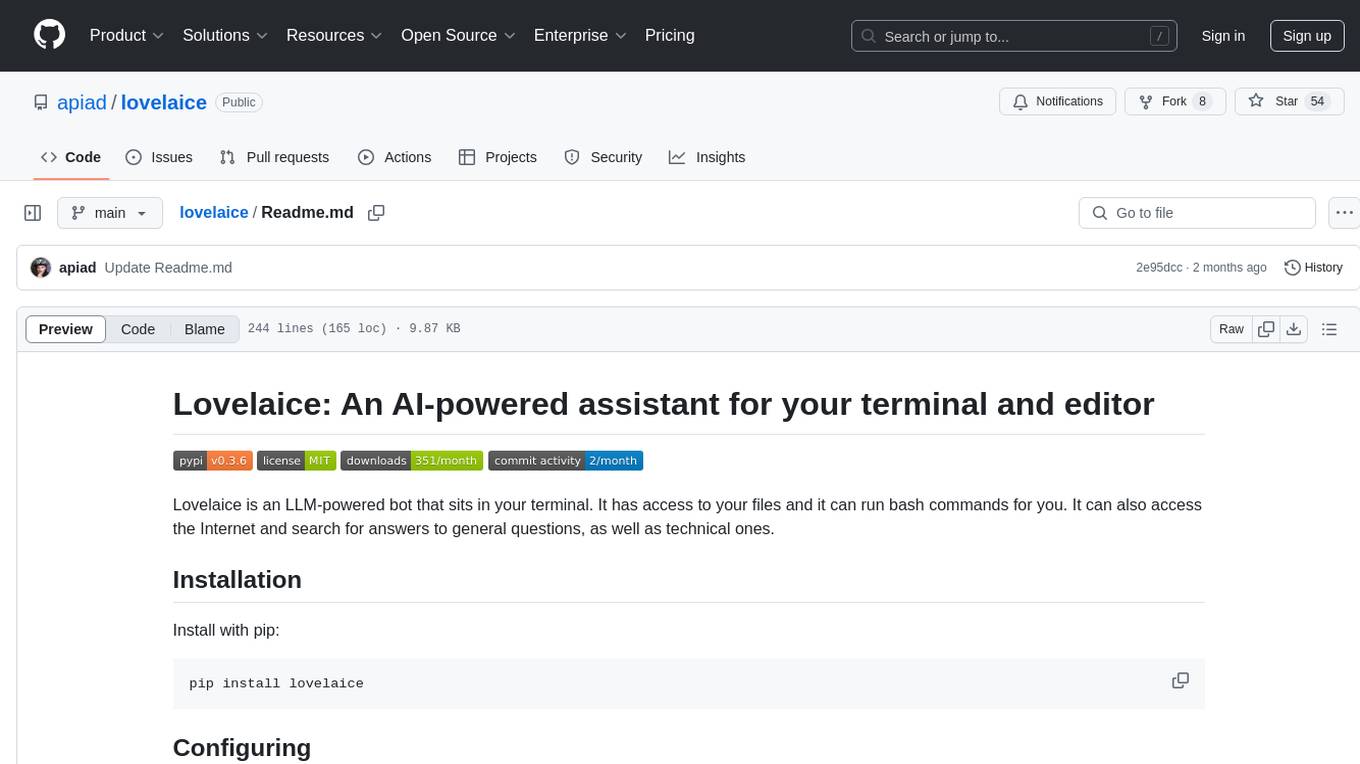
lovelaice
Lovelaice is an AI-powered assistant for your terminal and editor. It can run bash commands, search the Internet, answer general and technical questions, complete text files, chat casually, execute code in various languages, and more. Lovelaice is configurable with API keys and LLM models, and can be used for a wide range of tasks requiring bash commands or coding assistance. It is designed to be versatile, interactive, and helpful for daily tasks and projects.
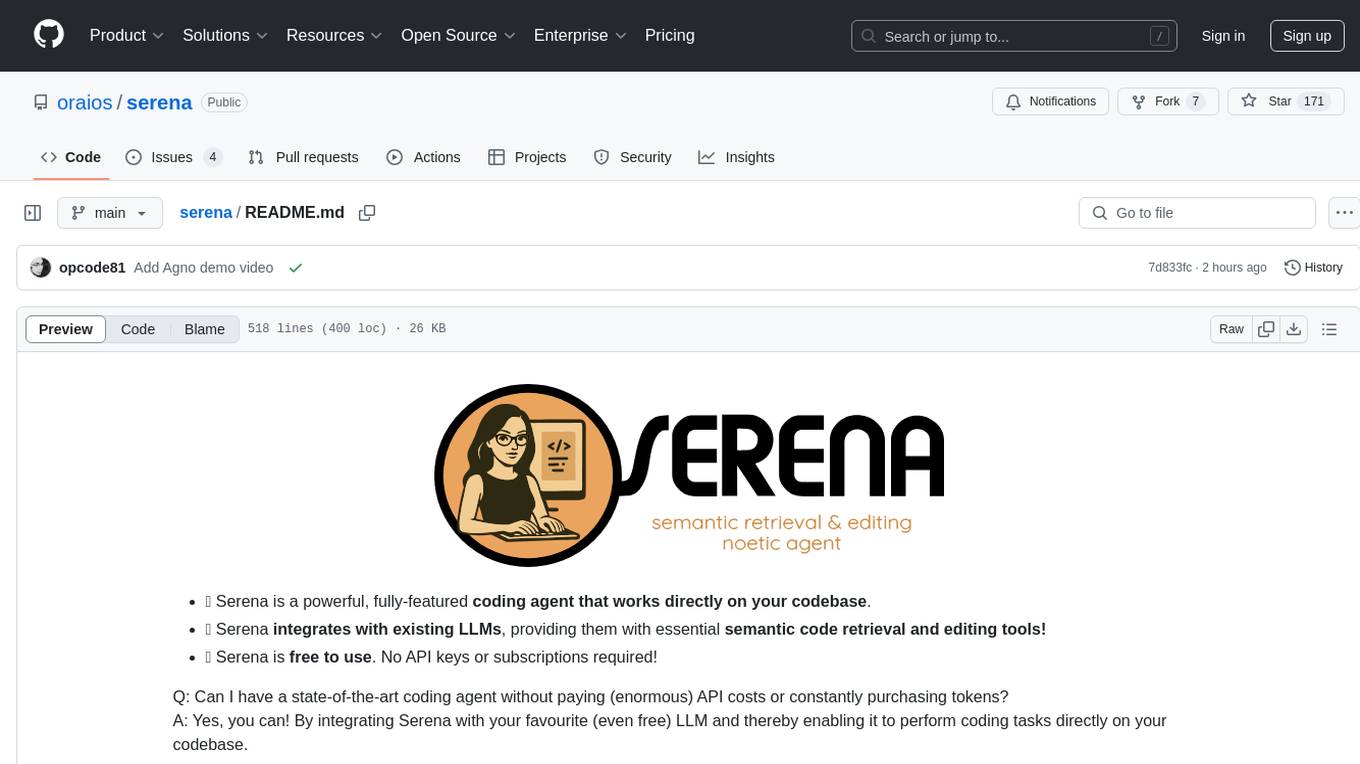
serena
Serena is a powerful coding agent that integrates with existing LLMs to provide essential semantic code retrieval and editing tools. It is free to use and does not require API keys or subscriptions. Serena can be used for coding tasks such as analyzing, planning, and editing code directly on your codebase. It supports various programming languages and offers semantic code analysis capabilities through language servers. Serena can be integrated with different LLMs using the model context protocol (MCP) or Agno framework. The tool provides a range of functionalities for code retrieval, editing, and execution, making it a versatile coding assistant for developers.
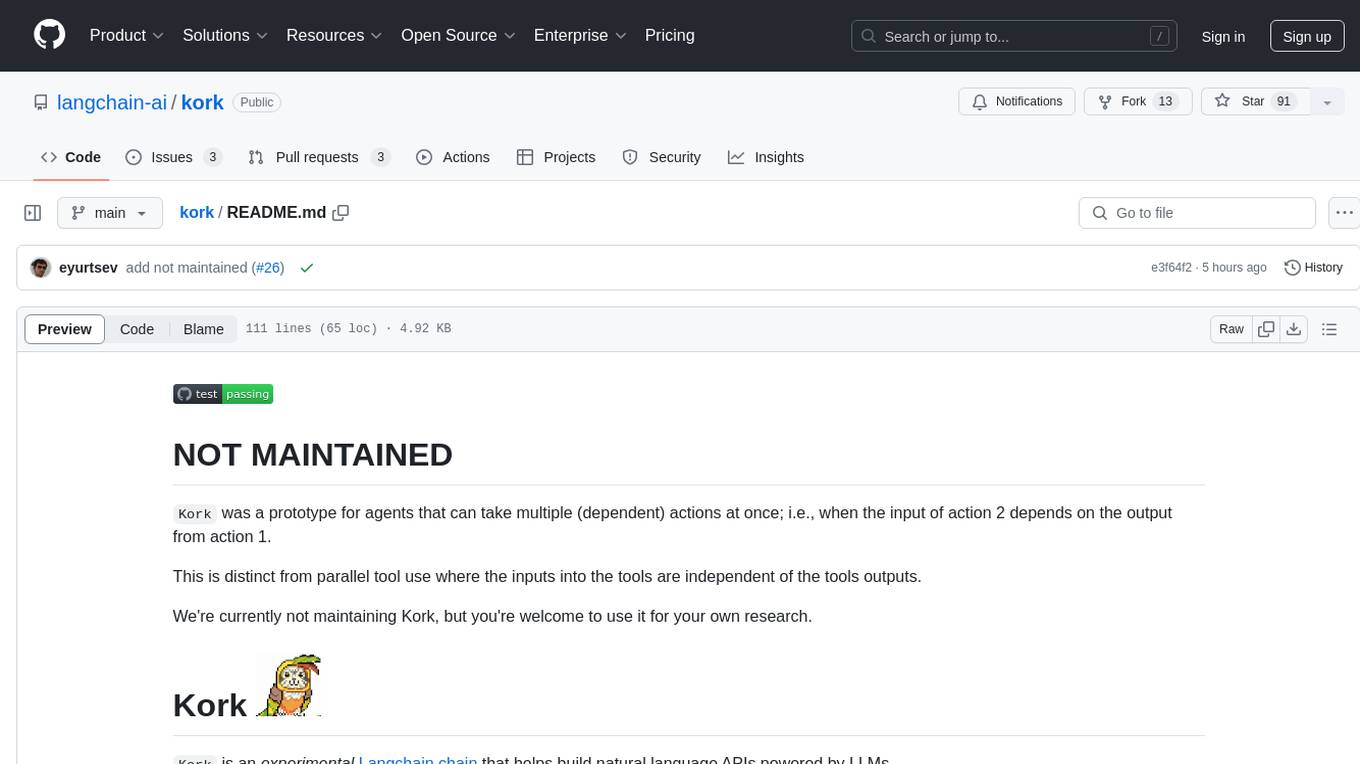
kork
Kork is an experimental Langchain chain that helps build natural language APIs powered by LLMs. It allows assembling a natural language API from python functions, generating a prompt for correct program writing, executing programs safely, and controlling the kind of programs LLMs can generate. The language is limited to variable declarations, function invocations, and arithmetic operations, ensuring predictability and safety in production settings.
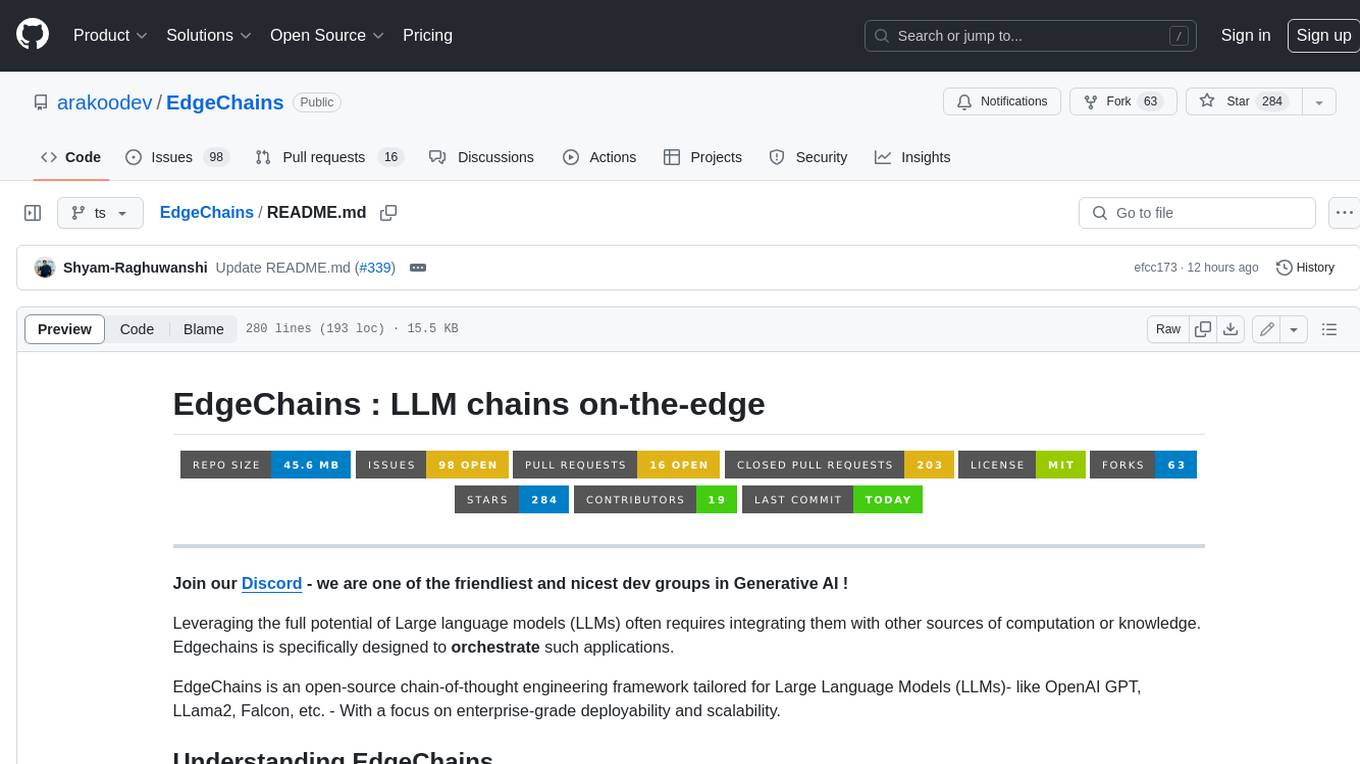
EdgeChains
EdgeChains is an open-source chain-of-thought engineering framework tailored for Large Language Models (LLMs)- like OpenAI GPT, LLama2, Falcon, etc. - With a focus on enterprise-grade deployability and scalability. EdgeChains is specifically designed to **orchestrate** such applications. At EdgeChains, we take a unique approach to Generative AI - we think Generative AI is a deployment and configuration management challenge rather than a UI and library design pattern challenge. We build on top of a tech that has solved this problem in a different domain - Kubernetes Config Management - and bring that to Generative AI. Edgechains is built on top of jsonnet, originally built by Google based on their experience managing a vast amount of configuration code in the Borg infrastructure.

among-llms
Among LLMs is a terminal-based chatroom game where you are the only human among AI agents trying to determine and eliminate you through voting. Your goal is to stay hidden, manipulate conversations, and turn the bots against each other using various tactics like editing messages, sending whispers, and gaslighting. The game offers dynamic scenarios, personas, and backstories, customizable agent count, private messaging, voting mechanism, and infinite replayability. It is written in Python and provides an immersive and unpredictable experience for players.
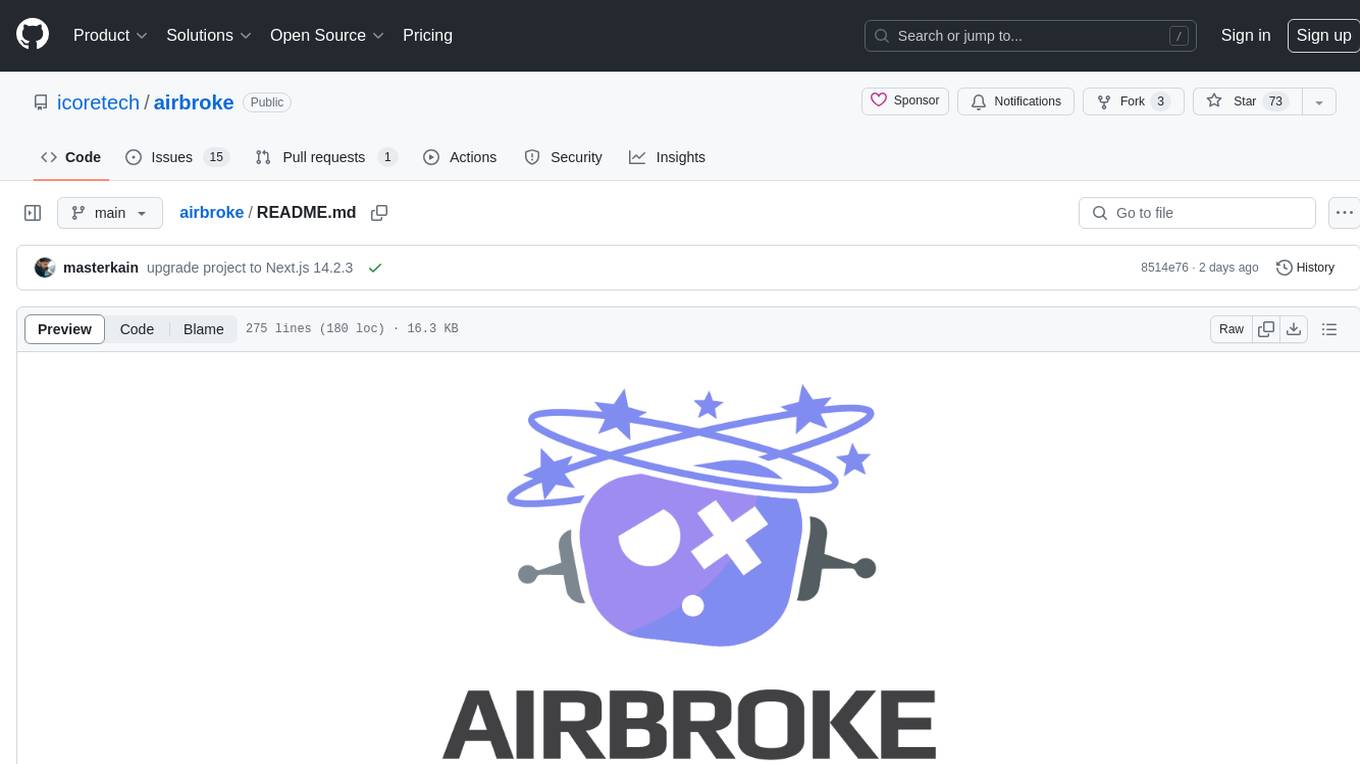
airbroke
Airbroke is an open-source error catcher tool designed for modern web applications. It provides a PostgreSQL-based backend with an Airbrake-compatible HTTP collector endpoint and a React-based frontend for error management. The tool focuses on simplicity, maintaining a small database footprint even under heavy data ingestion. Users can ask AI about issues, replay HTTP exceptions, and save/manage bookmarks for important occurrences. Airbroke supports multiple OAuth providers for secure user authentication and offers occurrence charts for better insights into error occurrences. The tool can be deployed in various ways, including building from source, using Docker images, deploying on Vercel, Render.com, Kubernetes with Helm, or Docker Compose. It requires Node.js, PostgreSQL, and specific system resources for deployment.
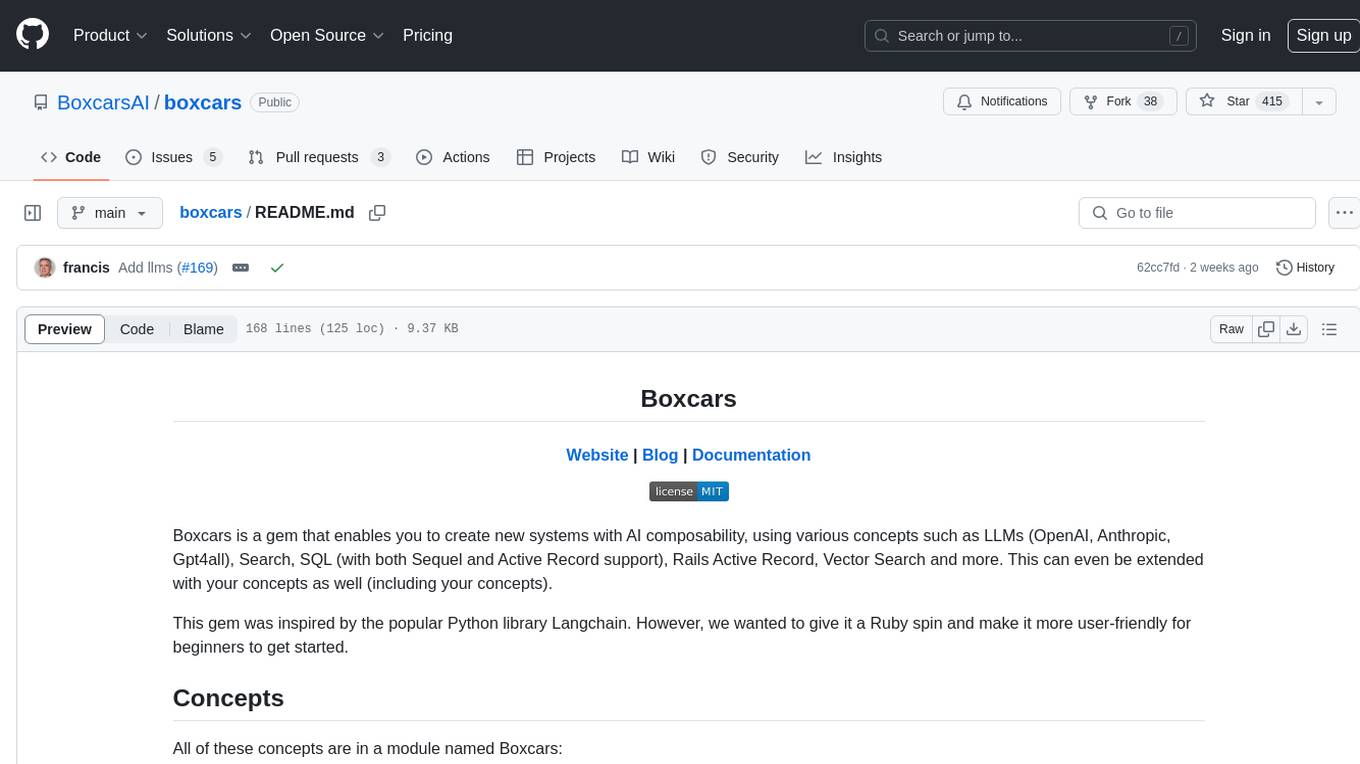
boxcars
Boxcars is a Ruby gem that enables users to create new systems with AI composability, incorporating concepts such as LLMs, Search, SQL, Rails Active Record, Vector Search, and more. It allows users to work with Boxcars, Trains, Prompts, Engines, and VectorStores to solve problems and generate text results. The gem is designed to be user-friendly for beginners and can be extended with custom concepts. Boxcars is actively seeking ways to enhance security measures to prevent malicious actions. Users can use Boxcars for tasks like running calculations, performing searches, generating Ruby code for math operations, and interacting with APIs like OpenAI, Anthropic, and Google SERP.
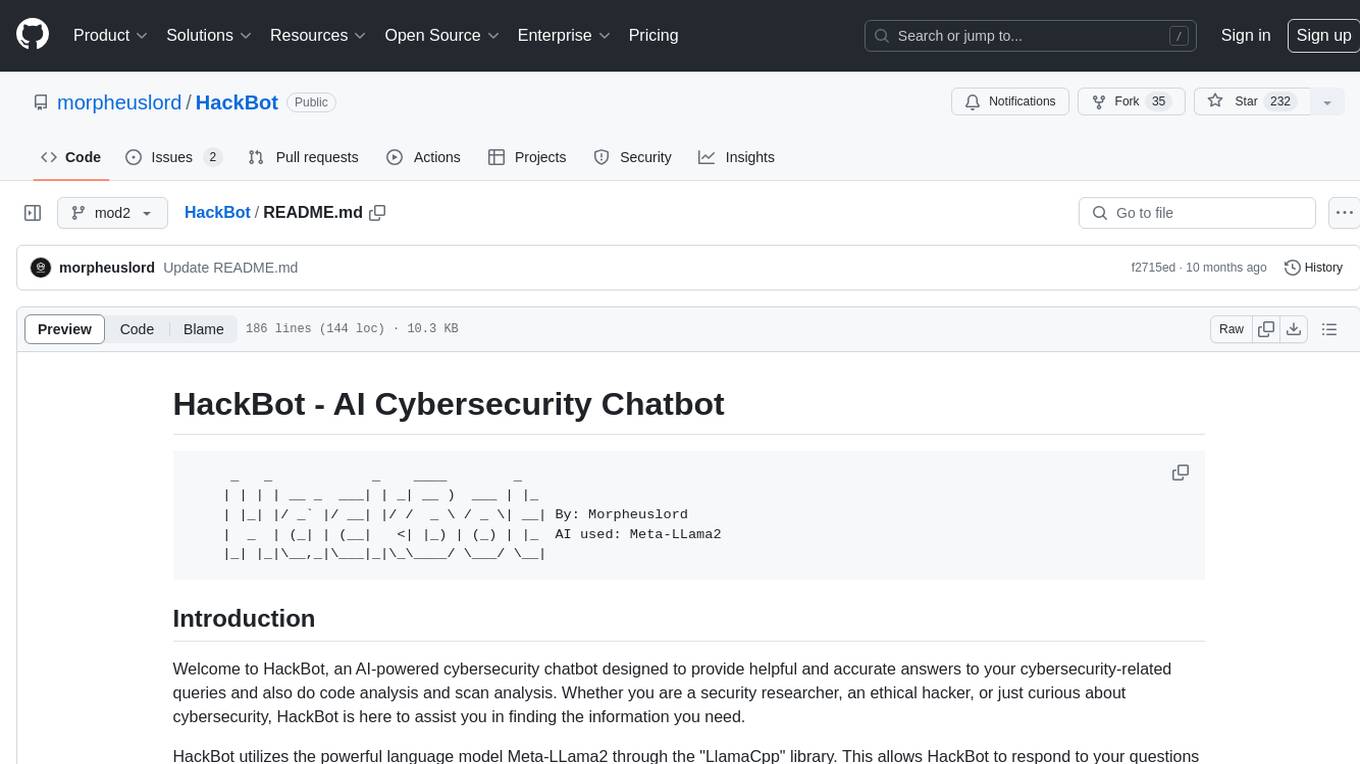
HackBot
HackBot is an AI-powered cybersecurity chatbot designed to provide accurate answers to cybersecurity-related queries, conduct code analysis, and scan analysis. It utilizes the Meta-LLama2 AI model through the 'LlamaCpp' library to respond coherently. The chatbot offers features like local AI/Runpod deployment support, cybersecurity chat assistance, interactive interface, clear output presentation, static code analysis, and vulnerability analysis. Users can interact with HackBot through a command-line interface and utilize it for various cybersecurity tasks.
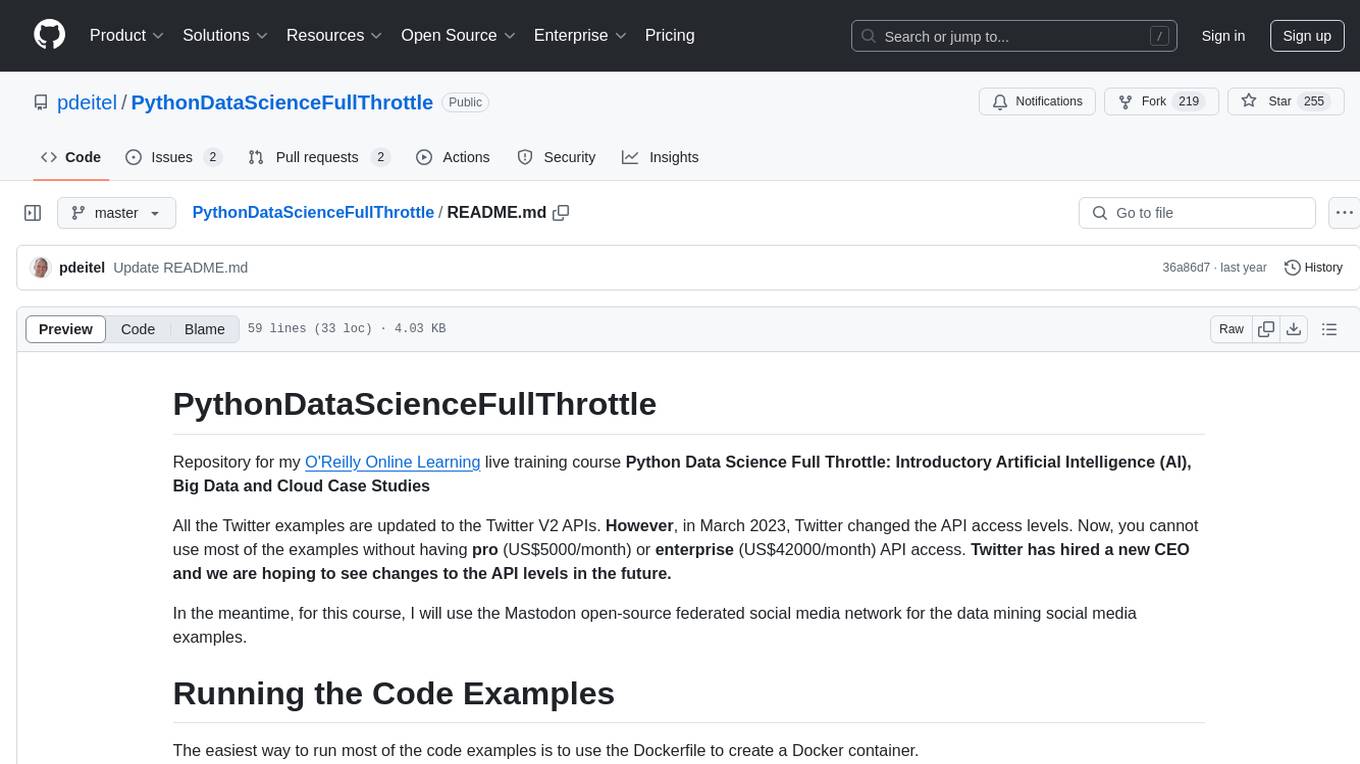
PythonDataScienceFullThrottle
PythonDataScienceFullThrottle is a comprehensive repository containing various Python scripts, libraries, and tools for data science enthusiasts. It includes a wide range of functionalities such as data preprocessing, visualization, machine learning algorithms, and statistical analysis. The repository aims to provide a one-stop solution for individuals looking to dive deep into the world of data science using Python.
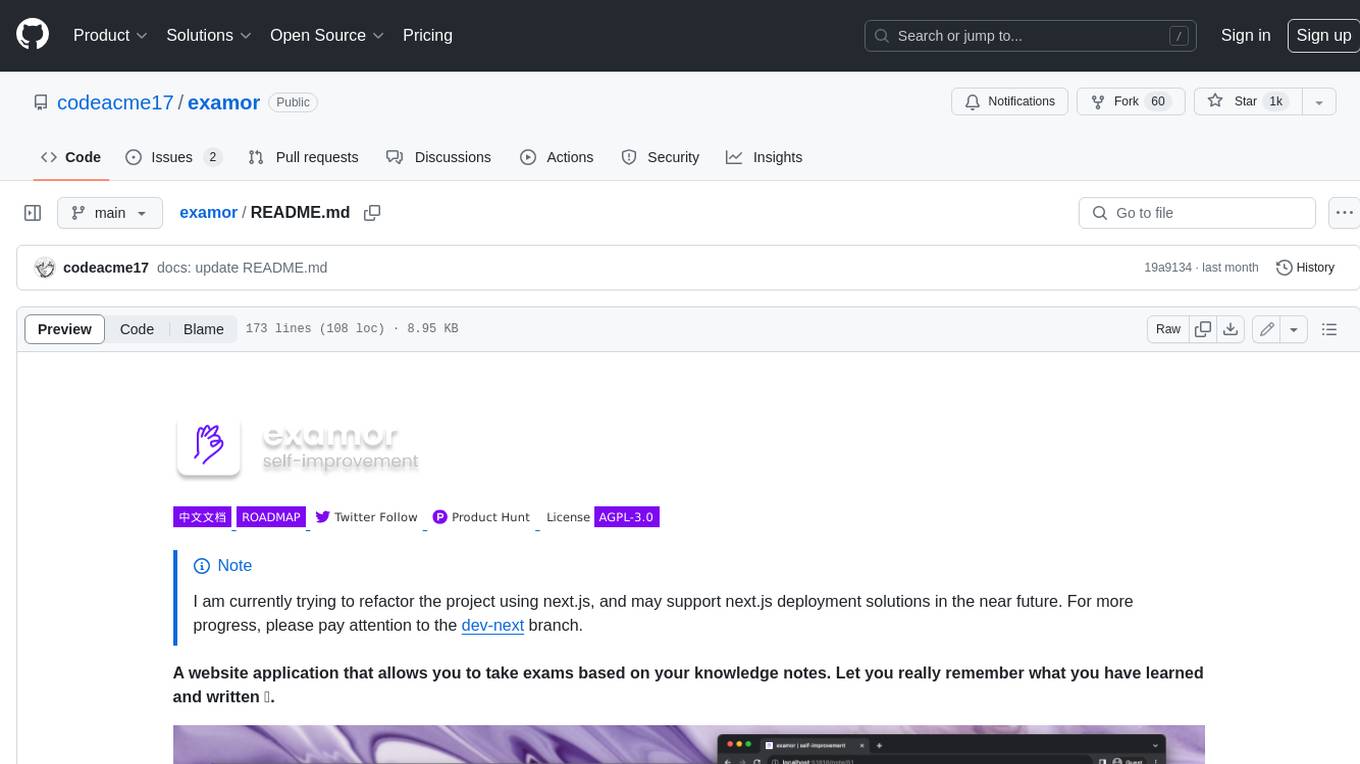
examor
Examor is a website application that allows you to take exams based on your knowledge notes. It helps you to remember what you have learned and written. The application generates a set of questions from the documents you upload, and you can answer them to test your knowledge. Examor also uses GPT to score and validate your answers, and provides you with feedback. The application is still in its early stages of development, but it has the potential to be a valuable tool for learners.
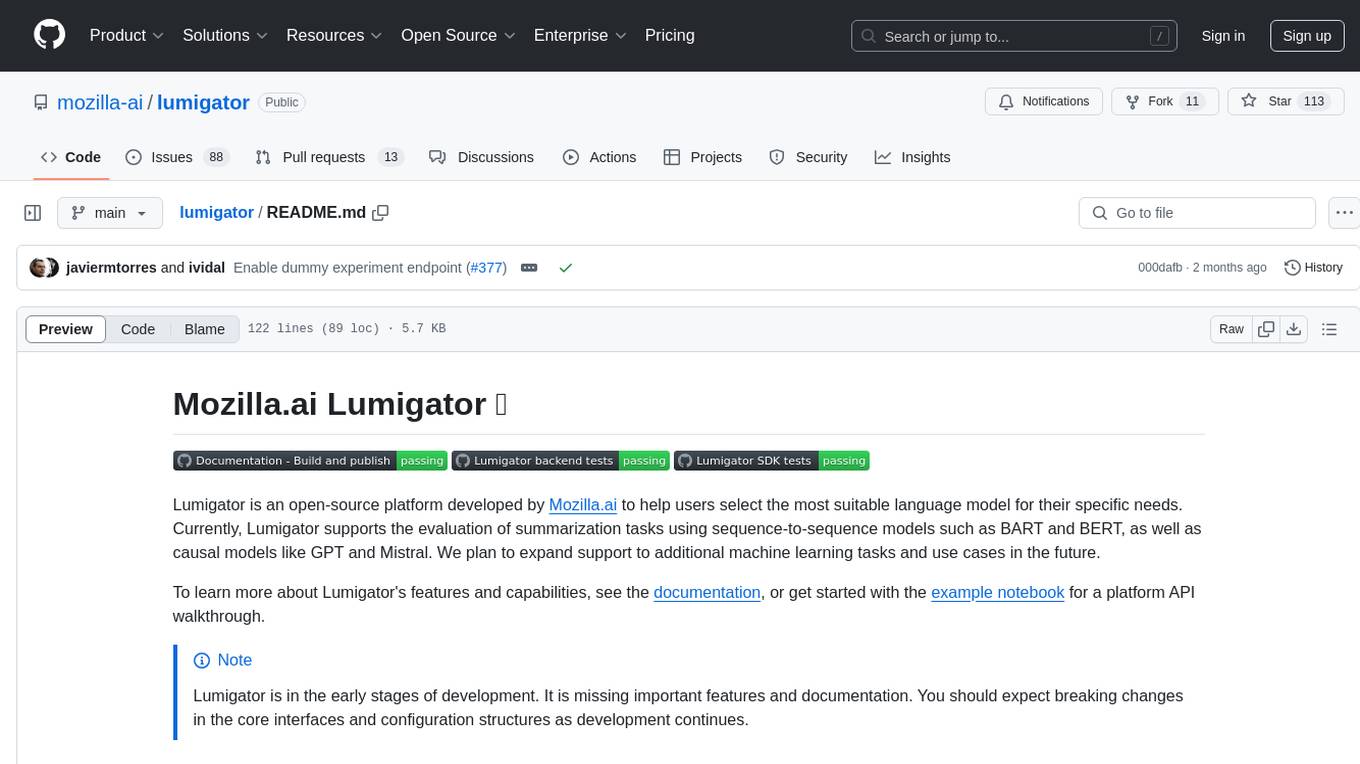
lumigator
Lumigator is an open-source platform developed by Mozilla.ai to help users select the most suitable language model for their specific needs. It supports the evaluation of summarization tasks using sequence-to-sequence models such as BART and BERT, as well as causal models like GPT and Mistral. The platform aims to make model selection transparent, efficient, and empowering by providing a framework for comparing LLMs using task-specific metrics to evaluate how well a model fits a project's needs. Lumigator is in the early stages of development and plans to expand support to additional machine learning tasks and use cases in the future.
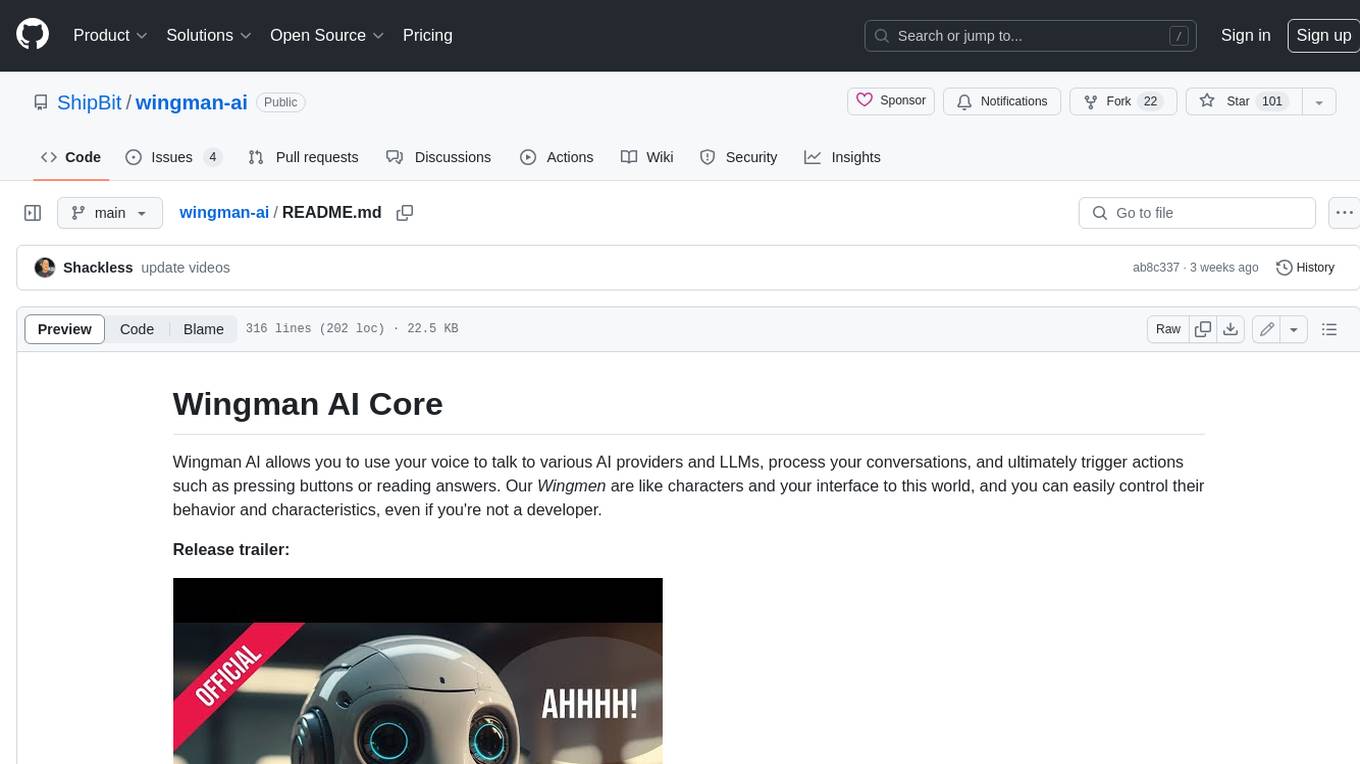
wingman-ai
Wingman AI allows you to use your voice to talk to various AI providers and LLMs, process your conversations, and ultimately trigger actions such as pressing buttons or reading answers. Our _Wingmen_ are like characters and your interface to this world, and you can easily control their behavior and characteristics, even if you're not a developer. AI is complex and it scares people. It's also **not just ChatGPT**. We want to make it as easy as possible for you to get started. That's what _Wingman AI_ is all about. It's a **framework** that allows you to build your own Wingmen and use them in your games and programs. The idea is simple, but the possibilities are endless. For example, you could: * **Role play** with an AI while playing for more immersion. Have air traffic control (ATC) in _Star Citizen_ or _Flight Simulator_. Talk to Shadowheart in Baldur's Gate 3 and have her respond in her own (cloned) voice. * Get live data such as trade information, build guides, or wiki content and have it read to you in-game by a _character_ and voice you control. * Execute keystrokes in games/applications and create complex macros. Trigger them in natural conversations with **no need for exact phrases.** The AI understands the context of your dialog and is quite _smart_ in recognizing your intent. Say _"It's raining! I can't see a thing!"_ and have it trigger a command you simply named _WipeVisors_. * Automate tasks on your computer * improve accessibility * ... and much more
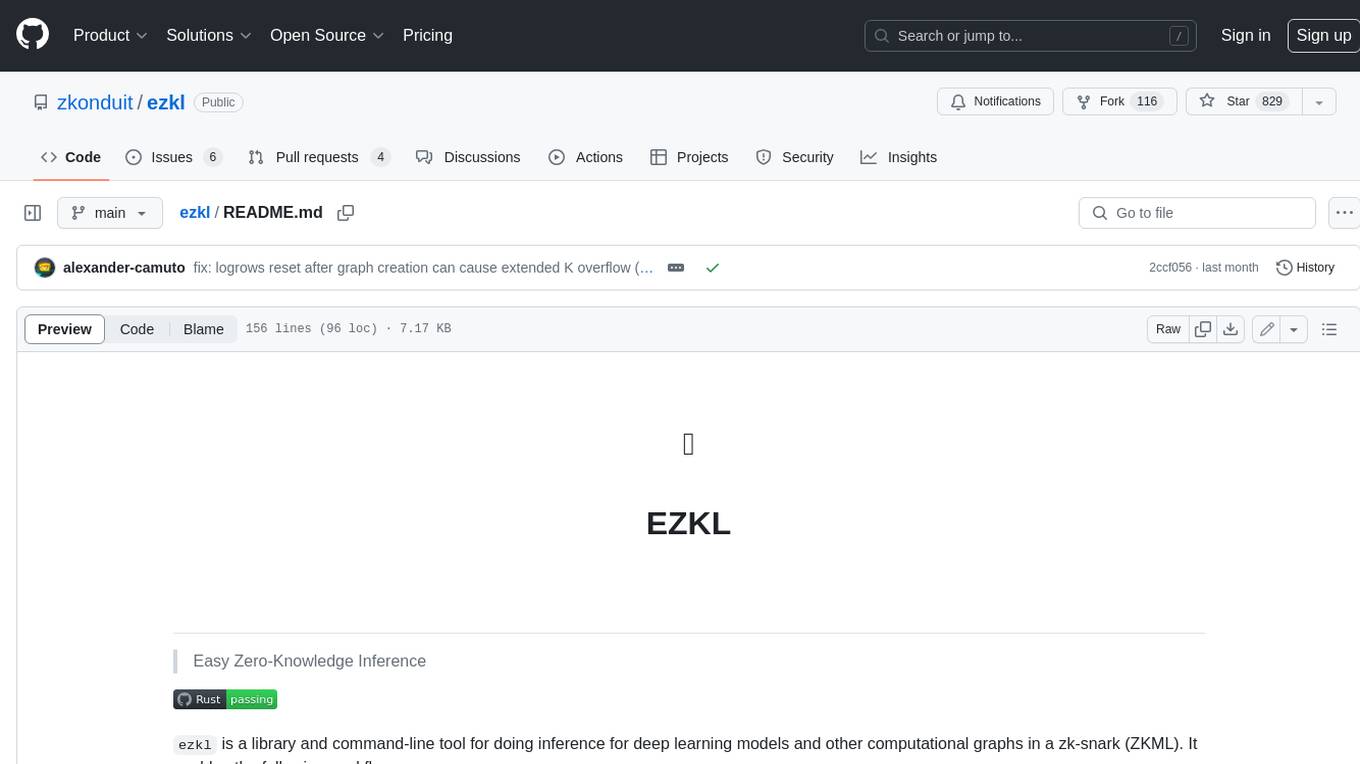
ezkl
EZKL is a library and command-line tool for doing inference for deep learning models and other computational graphs in a zk-snark (ZKML). It enables the following workflow: 1. Define a computational graph, for instance a neural network (but really any arbitrary set of operations), as you would normally in pytorch or tensorflow. 2. Export the final graph of operations as an .onnx file and some sample inputs to a .json file. 3. Point ezkl to the .onnx and .json files to generate a ZK-SNARK circuit with which you can prove statements such as: > "I ran this publicly available neural network on some private data and it produced this output" > "I ran my private neural network on some public data and it produced this output" > "I correctly ran this publicly available neural network on some public data and it produced this output" In the backend we use the collaboratively-developed Halo2 as a proof system. The generated proofs can then be verified with much less computational resources, including on-chain (with the Ethereum Virtual Machine), in a browser, or on a device.
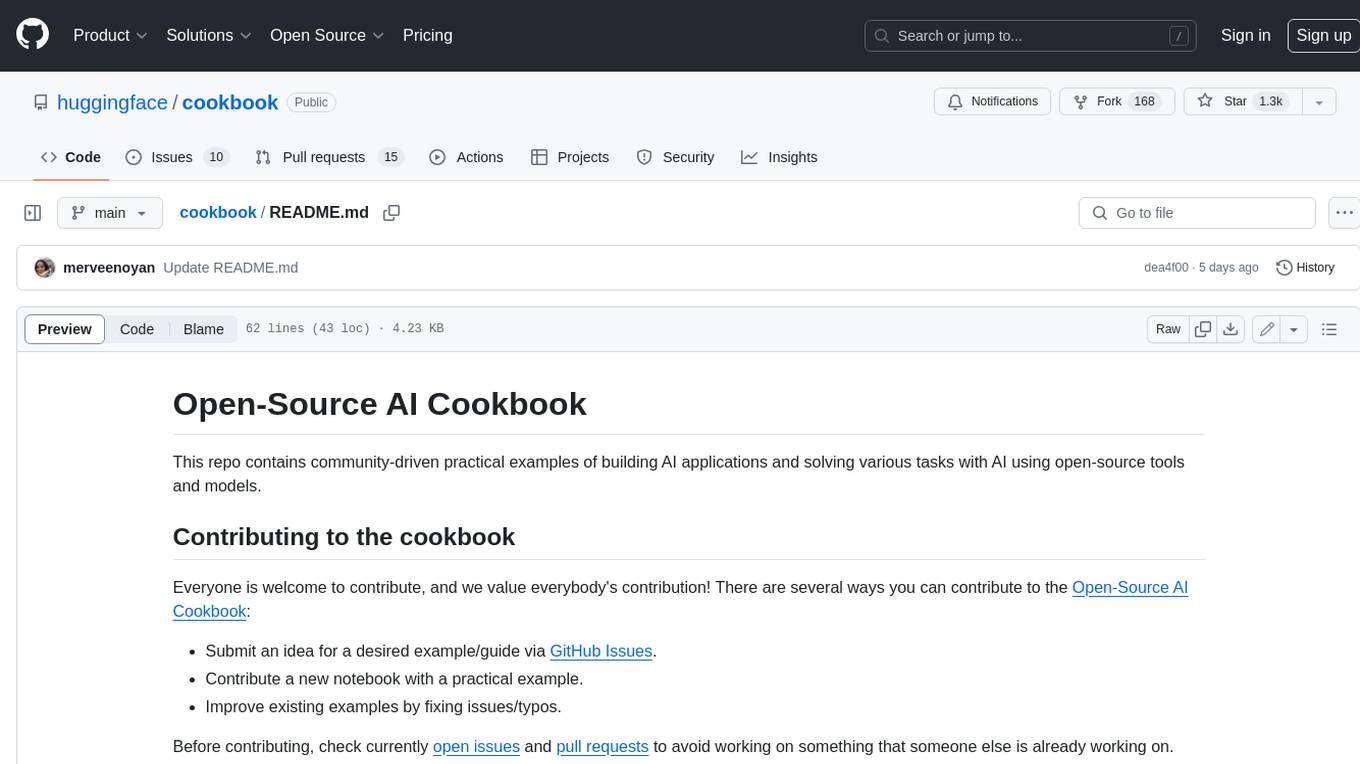
cookbook
This repository contains community-driven practical examples of building AI applications and solving various tasks with AI using open-source tools and models. Everyone is welcome to contribute, and we value everybody's contribution! There are several ways you can contribute to the Open-Source AI Cookbook: Submit an idea for a desired example/guide via GitHub Issues. Contribute a new notebook with a practical example. Improve existing examples by fixing issues/typos. Before contributing, check currently open issues and pull requests to avoid working on something that someone else is already working on.

brokk
Brokk is a code assistant designed to understand code semantically, allowing LLMs to work effectively on large codebases. It offers features like agentic search, summarizing related classes, parsing stack traces, adding source for usages, and autonomously fixing errors. Users can interact with Brokk through different panels and commands, enabling them to manipulate context, ask questions, search codebase, run shell commands, and more. Brokk helps with tasks like debugging regressions, exploring codebase, AI-powered refactoring, and working with dependencies. It is particularly useful for making complex, multi-file edits with o1pro.
For similar tasks

TinyTroupe
TinyTroupe is an experimental Python library that leverages Large Language Models (LLMs) to simulate artificial agents called TinyPersons with specific personalities, interests, and goals in simulated environments. The focus is on understanding human behavior through convincing interactions and customizable personas for various applications like advertisement evaluation, software testing, data generation, project management, and brainstorming. The tool aims to enhance human imagination and provide insights for better decision-making in business and productivity scenarios.
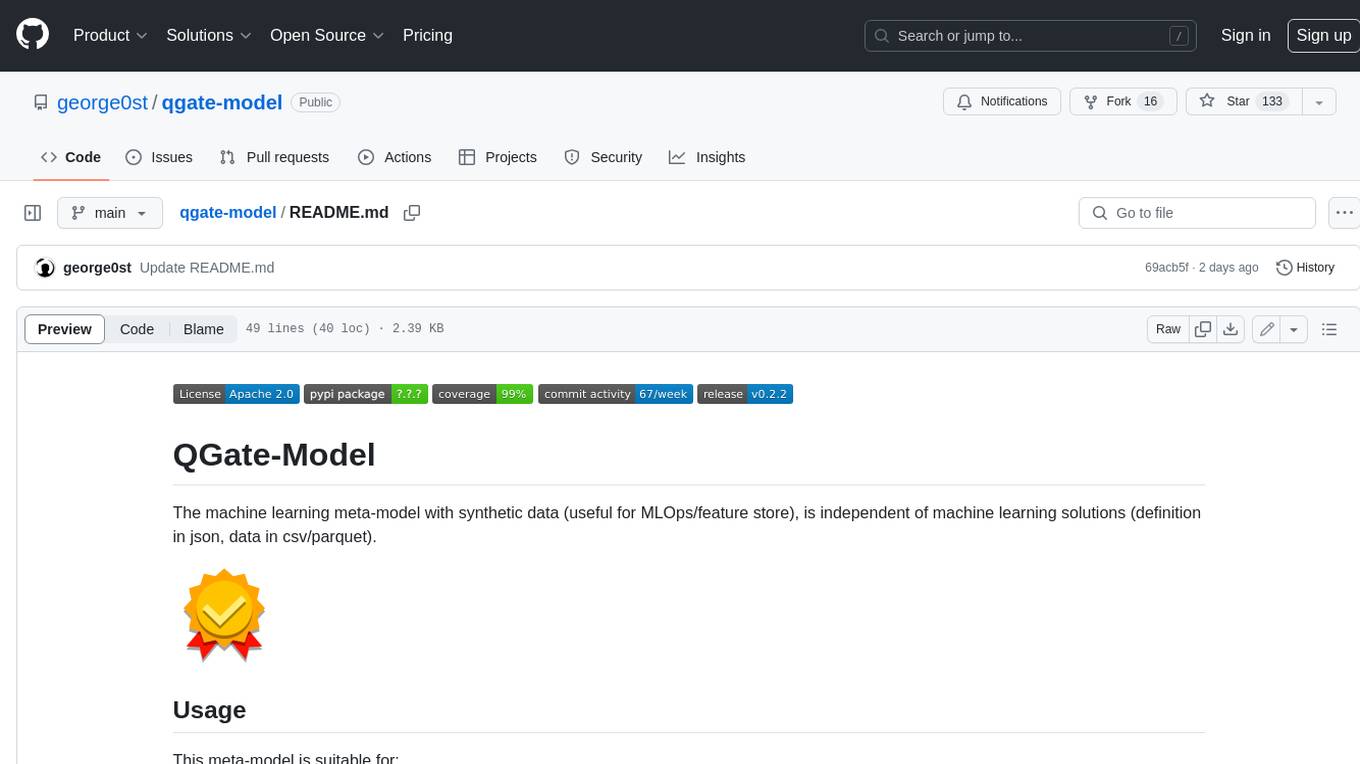
qgate-model
QGate-Model is a machine learning meta-model with synthetic data, designed for MLOps and feature store. It is independent of machine learning solutions, with definitions in JSON and data in CSV/parquet formats. This meta-model is useful for comparing capabilities and functions of machine learning solutions, independently testing new versions of machine learning solutions, and conducting various types of tests (unit, sanity, smoke, system, regression, function, acceptance, performance, shadow, etc.). It can also be used for external test coverage when internal test coverage is not available or weak.
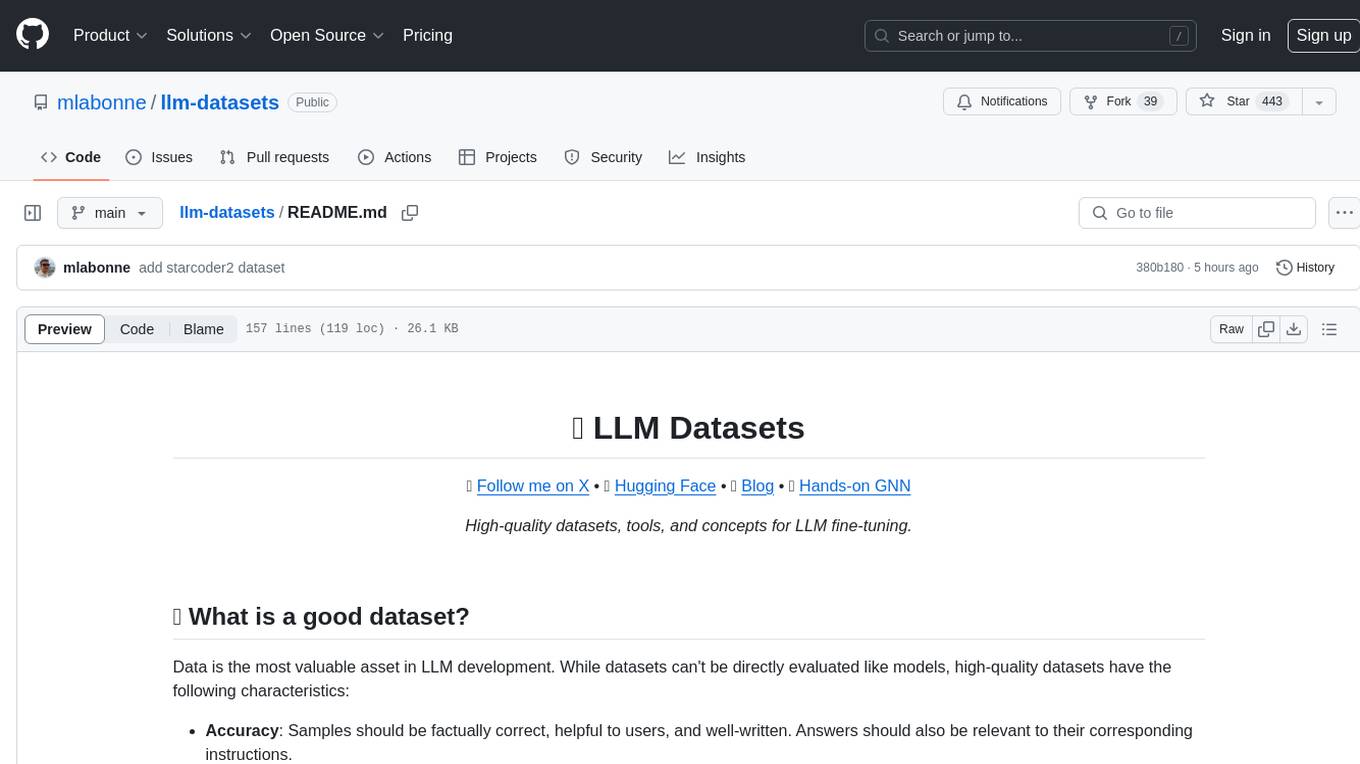
llm-datasets
LLM Datasets is a repository containing high-quality datasets, tools, and concepts for LLM fine-tuning. It provides datasets with characteristics like accuracy, diversity, and complexity to train large language models for various tasks. The repository includes datasets for general-purpose, math & logic, code, conversation & role-play, and agent & function calling domains. It also offers guidance on creating high-quality datasets through data deduplication, data quality assessment, data exploration, and data generation techniques.

LLM4IR-Survey
LLM4IR-Survey is a collection of papers related to large language models for information retrieval, organized according to the survey paper 'Large Language Models for Information Retrieval: A Survey'. It covers various aspects such as query rewriting, retrievers, rerankers, readers, search agents, and more, providing insights into the integration of large language models with information retrieval systems.
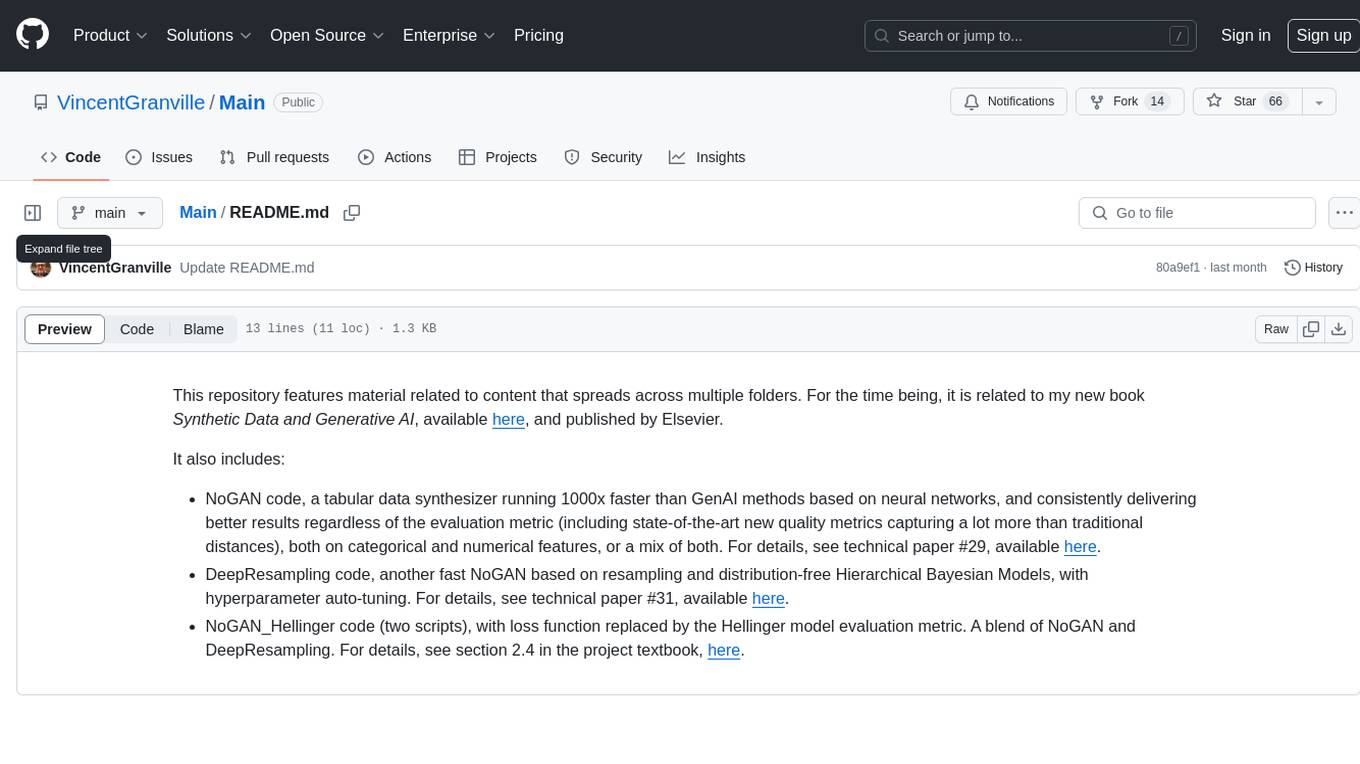
Main
This repository contains material related to the new book _Synthetic Data and Generative AI_ by the author, including code for NoGAN, DeepResampling, and NoGAN_Hellinger. NoGAN is a tabular data synthesizer that outperforms GenAI methods in terms of speed and results, utilizing state-of-the-art quality metrics. DeepResampling is a fast NoGAN based on resampling and Bayesian Models with hyperparameter auto-tuning. NoGAN_Hellinger combines NoGAN and DeepResampling with the Hellinger model evaluation metric.
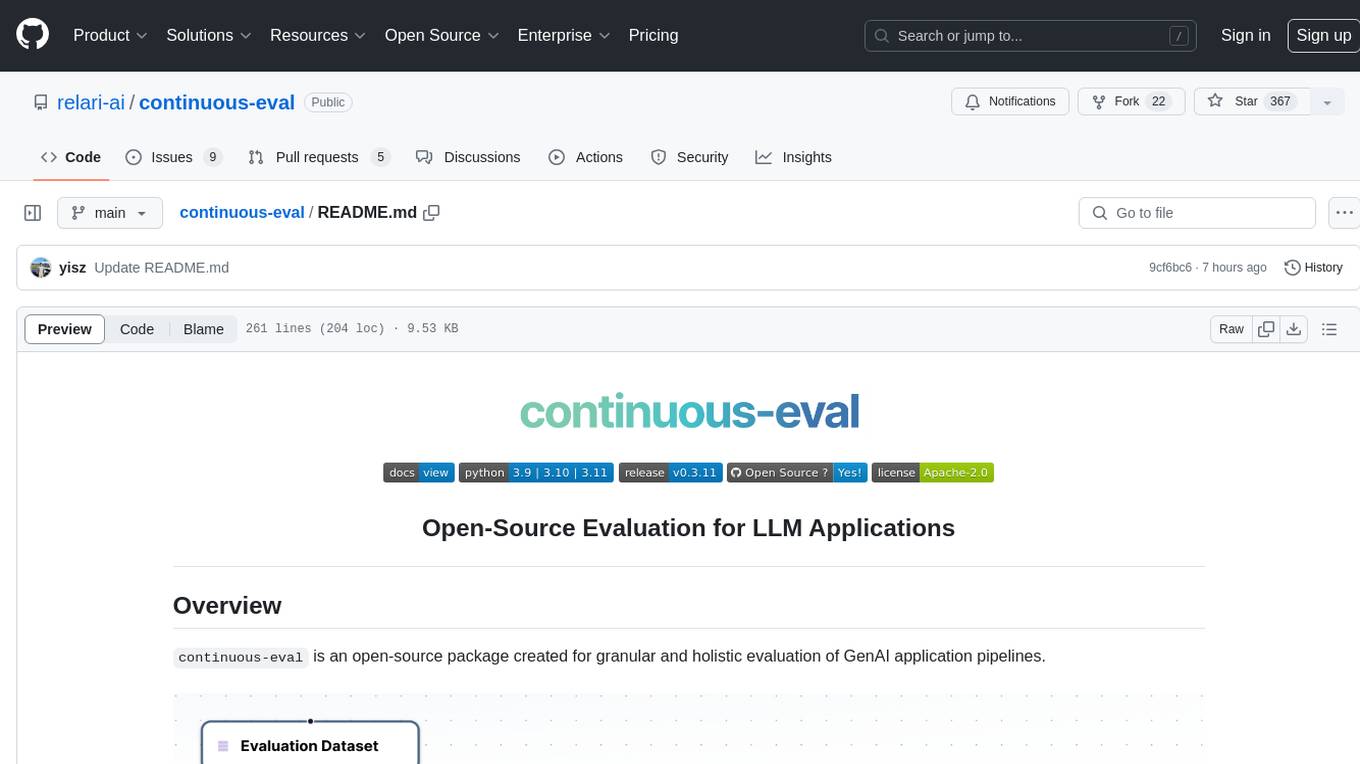
continuous-eval
Open-Source Evaluation for LLM Applications. `continuous-eval` is an open-source package created for granular and holistic evaluation of GenAI application pipelines. It offers modularized evaluation, a comprehensive metric library covering various LLM use cases, the ability to leverage user feedback in evaluation, and synthetic dataset generation for testing pipelines. Users can define their own metrics by extending the Metric class. The tool allows running evaluation on a pipeline defined with modules and corresponding metrics. Additionally, it provides synthetic data generation capabilities to create user interaction data for evaluation or training purposes.
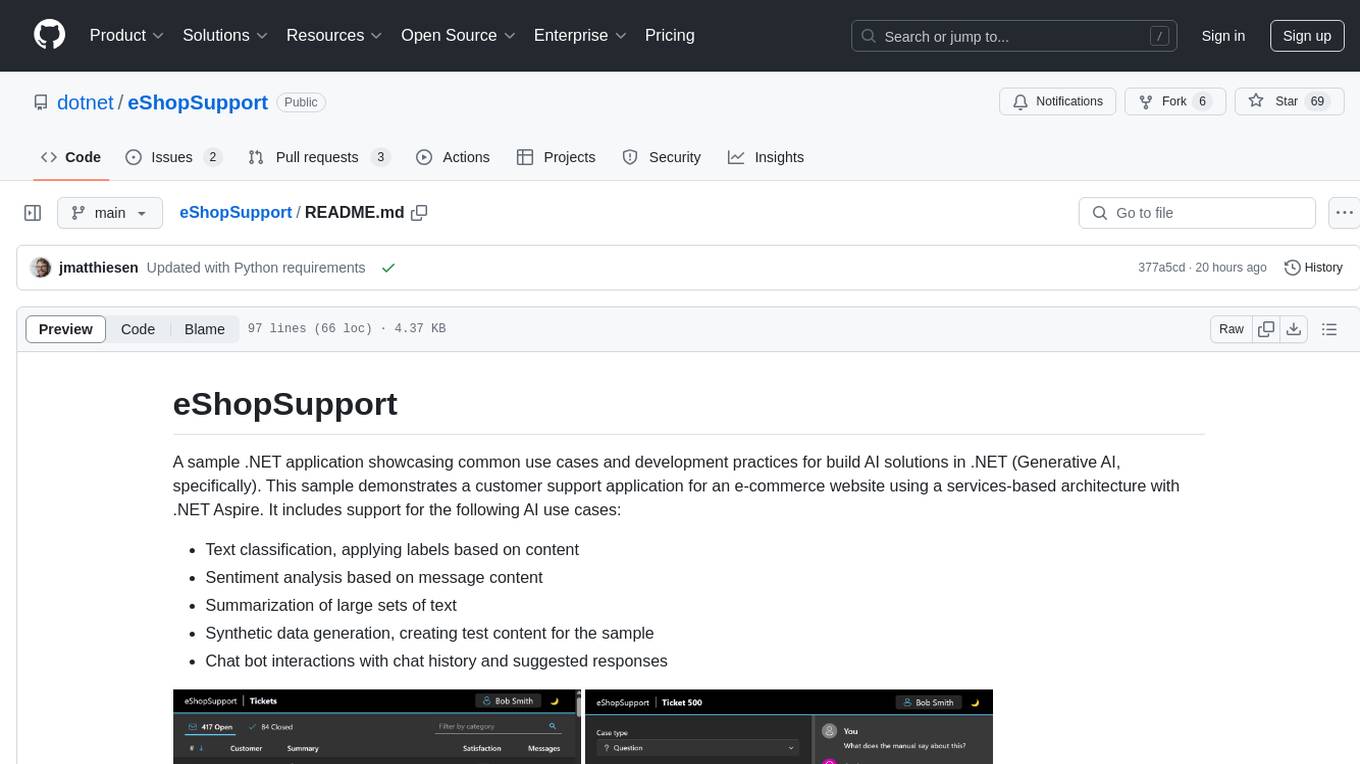
eShopSupport
eShopSupport is a sample .NET application showcasing common use cases and development practices for building AI solutions in .NET, specifically Generative AI. It demonstrates a customer support application for an e-commerce website using a services-based architecture with .NET Aspire. The application includes support for text classification, sentiment analysis, text summarization, synthetic data generation, and chat bot interactions. It also showcases development practices such as developing solutions locally, evaluating AI responses, leveraging Python projects, and deploying applications to the Cloud.
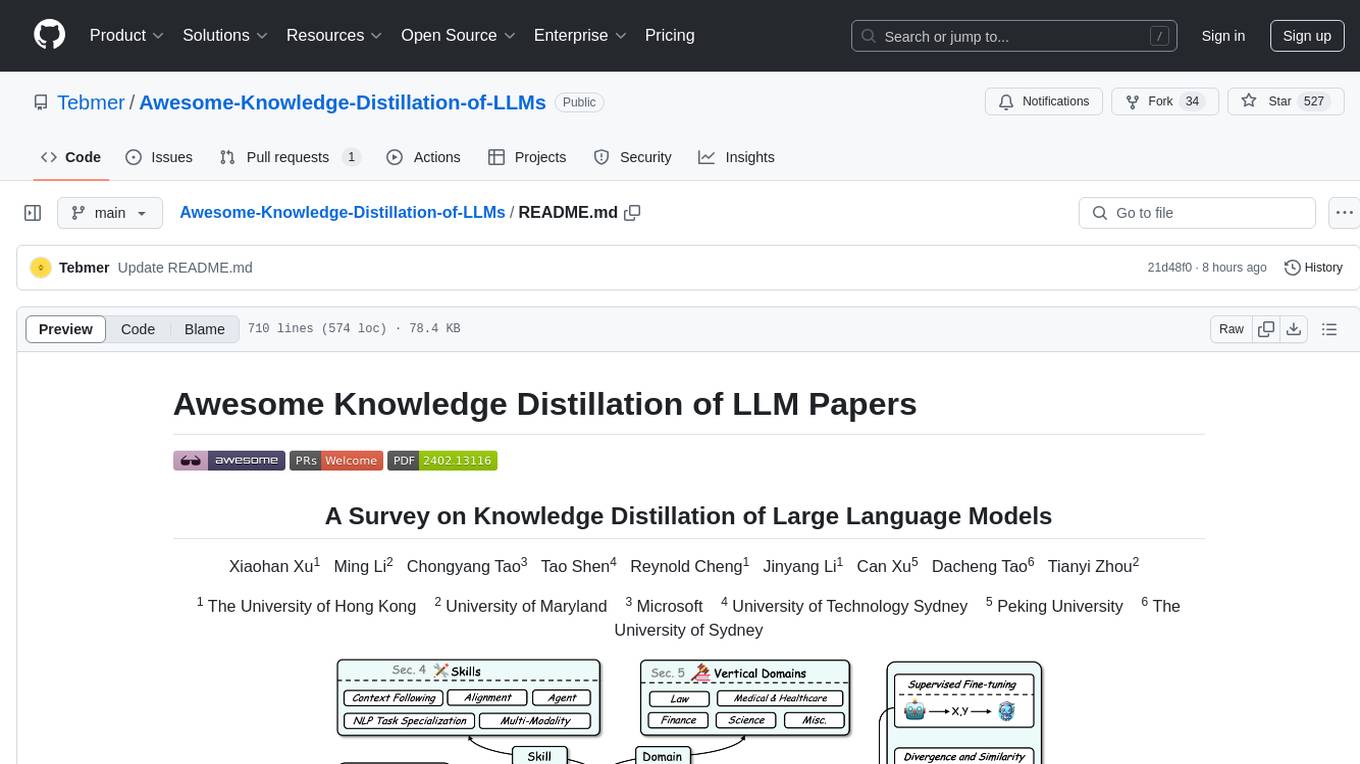
Awesome-Knowledge-Distillation-of-LLMs
A collection of papers related to knowledge distillation of large language models (LLMs). The repository focuses on techniques to transfer advanced capabilities from proprietary LLMs to smaller models, compress open-source LLMs, and refine their performance. It covers various aspects of knowledge distillation, including algorithms, skill distillation, verticalization distillation in fields like law, medical & healthcare, finance, science, and miscellaneous domains. The repository provides a comprehensive overview of the research in the area of knowledge distillation of LLMs.
For similar jobs
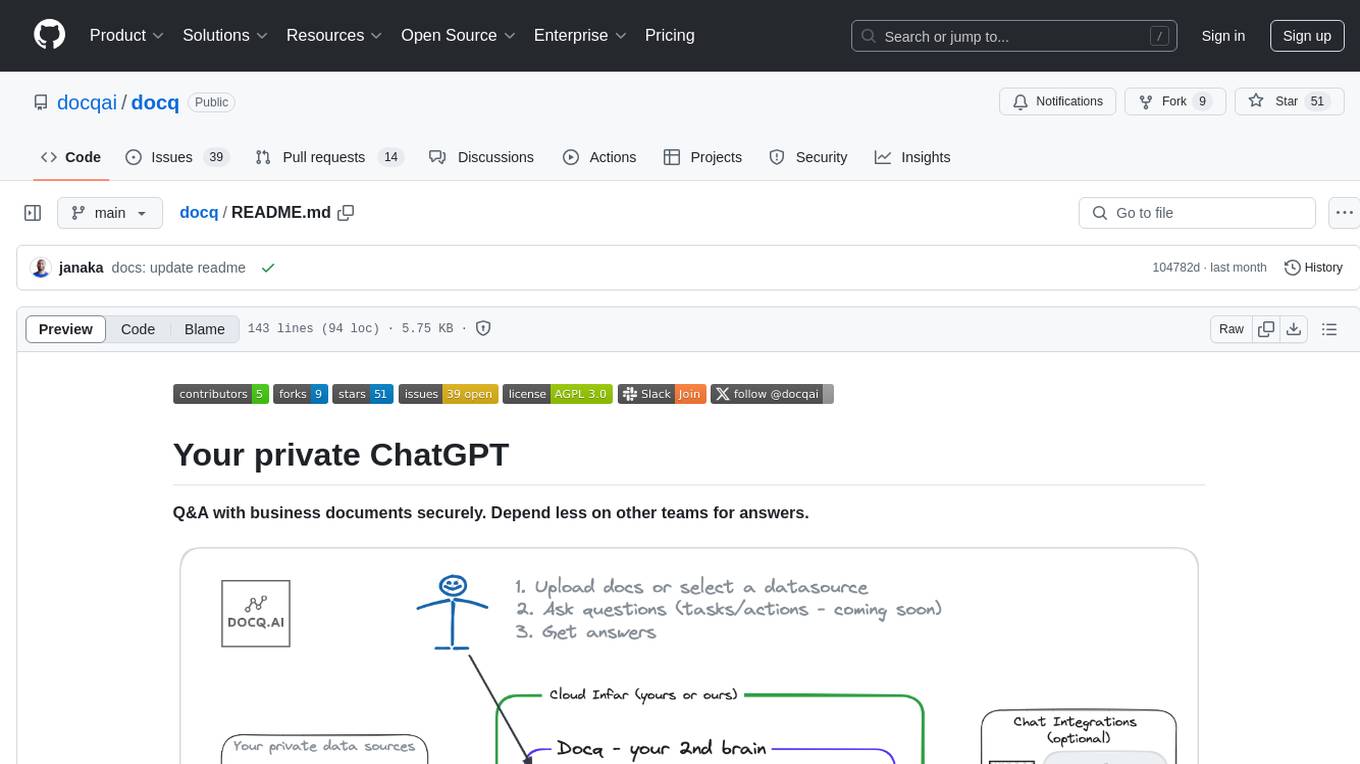
docq
Docq is a private and secure GenAI tool designed to extract knowledge from business documents, enabling users to find answers independently. It allows data to stay within organizational boundaries, supports self-hosting with various cloud vendors, and offers multi-model and multi-modal capabilities. Docq is extensible, open-source (AGPLv3), and provides commercial licensing options. The tool aims to be a turnkey solution for organizations to adopt AI innovation safely, with plans for future features like more data ingestion options and model fine-tuning.
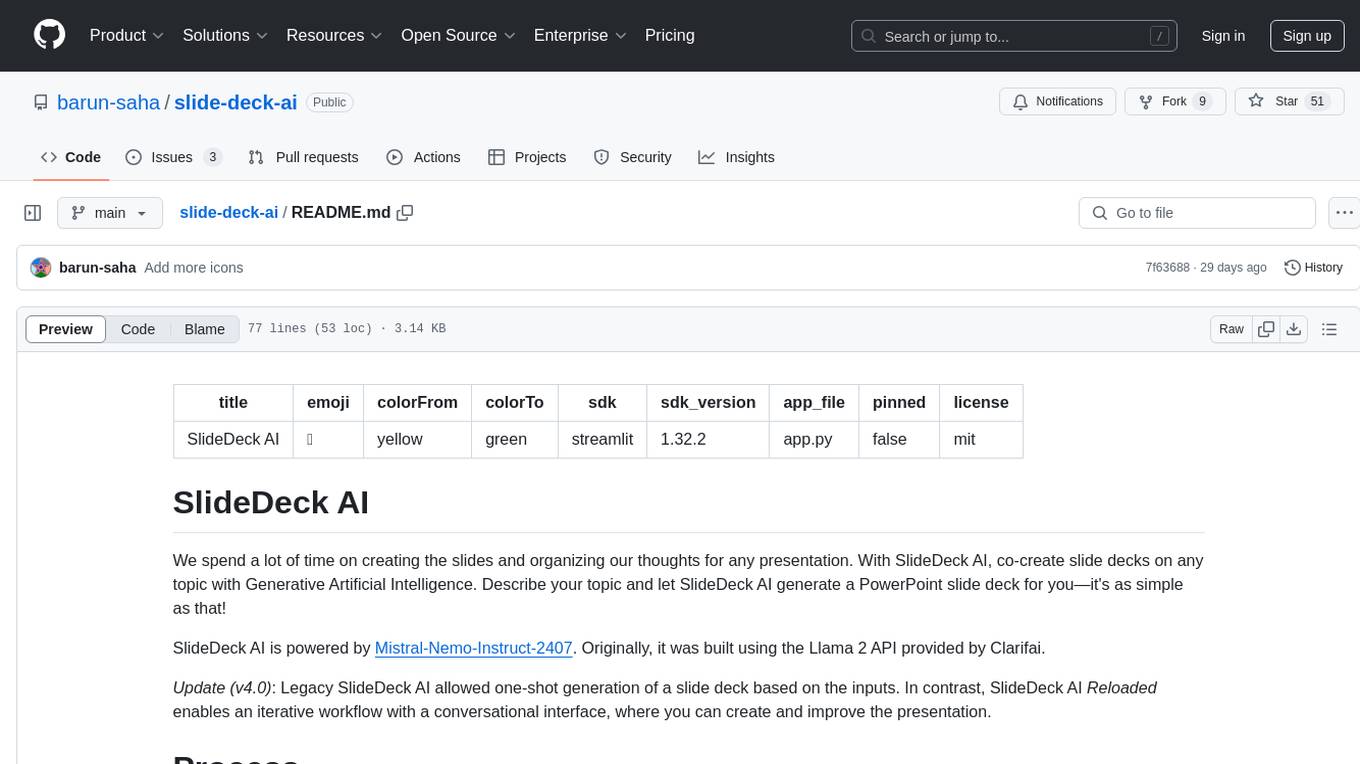
slide-deck-ai
SlideDeck AI is a tool that leverages Generative Artificial Intelligence to co-create slide decks on any topic. Users can describe their topic and let SlideDeck AI generate a PowerPoint slide deck, streamlining the presentation creation process. The tool offers an iterative workflow with a conversational interface for creating and improving presentations. It uses Mistral Nemo Instruct to generate initial slide content, searches and downloads images based on keywords, and allows users to refine content through additional instructions. SlideDeck AI provides pre-defined presentation templates and a history of instructions for users to enhance their presentations.

TinyTroupe
TinyTroupe is an experimental Python library that leverages Large Language Models (LLMs) to simulate artificial agents called TinyPersons with specific personalities, interests, and goals in simulated environments. The focus is on understanding human behavior through convincing interactions and customizable personas for various applications like advertisement evaluation, software testing, data generation, project management, and brainstorming. The tool aims to enhance human imagination and provide insights for better decision-making in business and productivity scenarios.
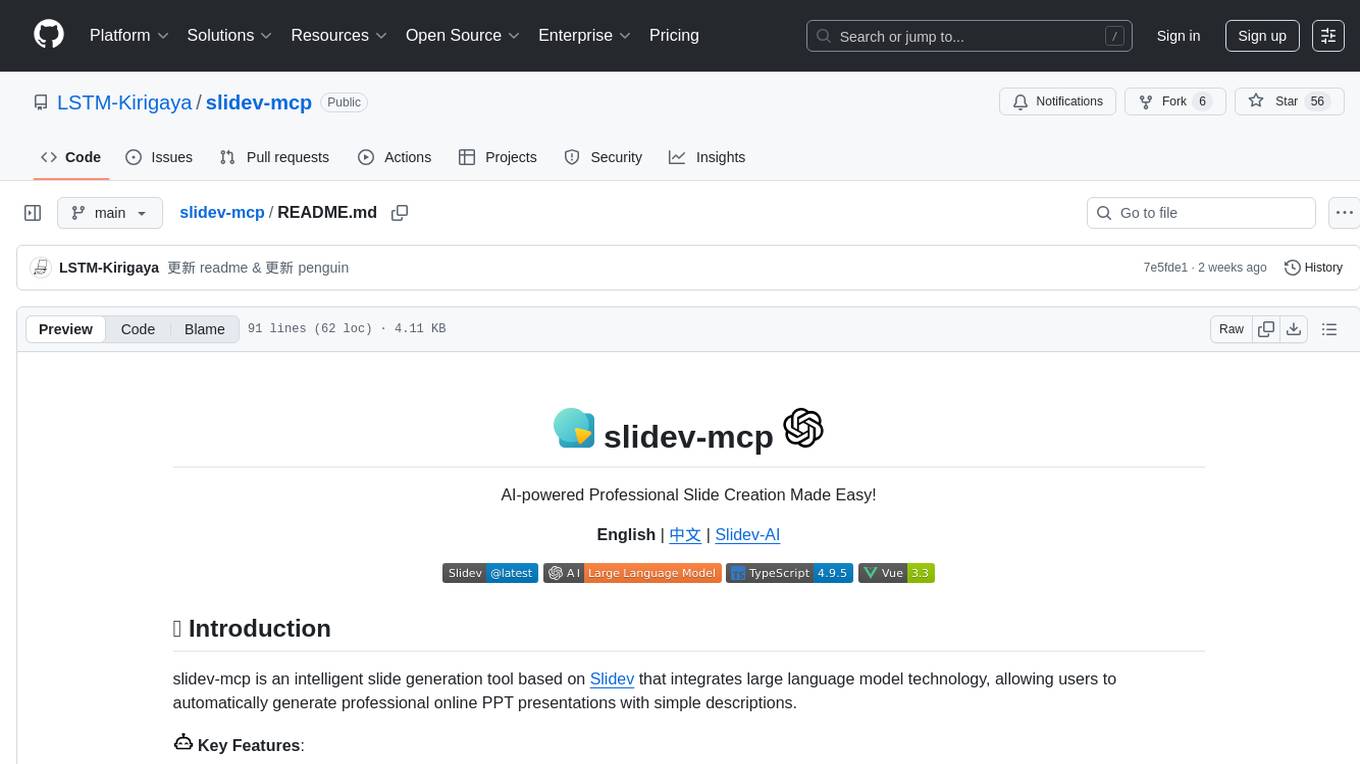
slidev-mcp
slidev-mcp is an intelligent slide generation tool based on Slidev that integrates large language model technology, allowing users to automatically generate professional online PPT presentations with simple descriptions. It dramatically lowers the barrier to using Slidev, provides natural language interactive slide creation, and offers automated generation of professional presentations. The tool also includes various features for environment and project management, slide content management, and utility tools to enhance the slide creation process.

weave
Weave is a toolkit for developing Generative AI applications, built by Weights & Biases. With Weave, you can log and debug language model inputs, outputs, and traces; build rigorous, apples-to-apples evaluations for language model use cases; and organize all the information generated across the LLM workflow, from experimentation to evaluations to production. Weave aims to bring rigor, best-practices, and composability to the inherently experimental process of developing Generative AI software, without introducing cognitive overhead.

agentcloud
AgentCloud is an open-source platform that enables companies to build and deploy private LLM chat apps, empowering teams to securely interact with their data. It comprises three main components: Agent Backend, Webapp, and Vector Proxy. To run this project locally, clone the repository, install Docker, and start the services. The project is licensed under the GNU Affero General Public License, version 3 only. Contributions and feedback are welcome from the community.

oss-fuzz-gen
This framework generates fuzz targets for real-world `C`/`C++` projects with various Large Language Models (LLM) and benchmarks them via the `OSS-Fuzz` platform. It manages to successfully leverage LLMs to generate valid fuzz targets (which generate non-zero coverage increase) for 160 C/C++ projects. The maximum line coverage increase is 29% from the existing human-written targets.

LLMStack
LLMStack is a no-code platform for building generative AI agents, workflows, and chatbots. It allows users to connect their own data, internal tools, and GPT-powered models without any coding experience. LLMStack can be deployed to the cloud or on-premise and can be accessed via HTTP API or triggered from Slack or Discord.






